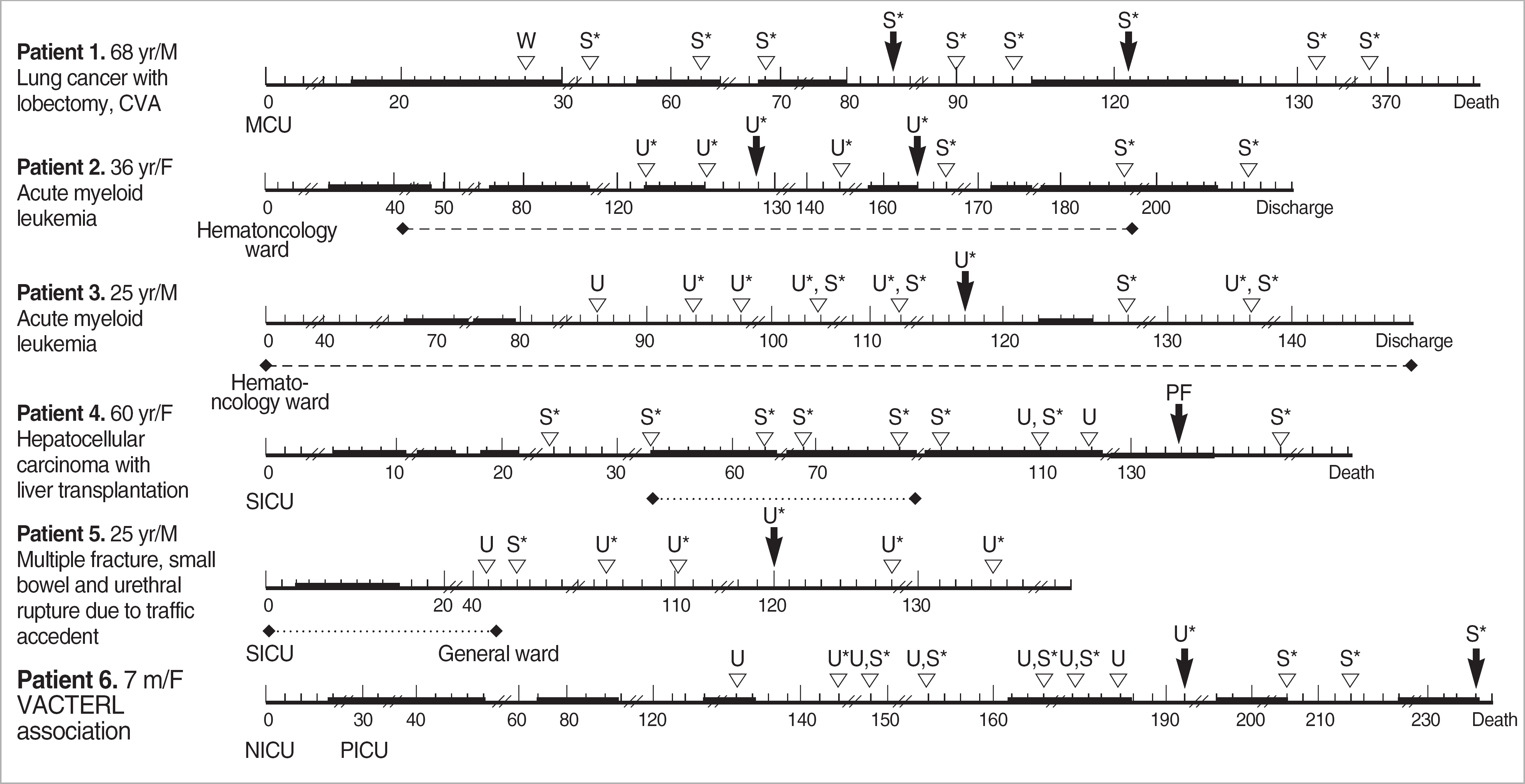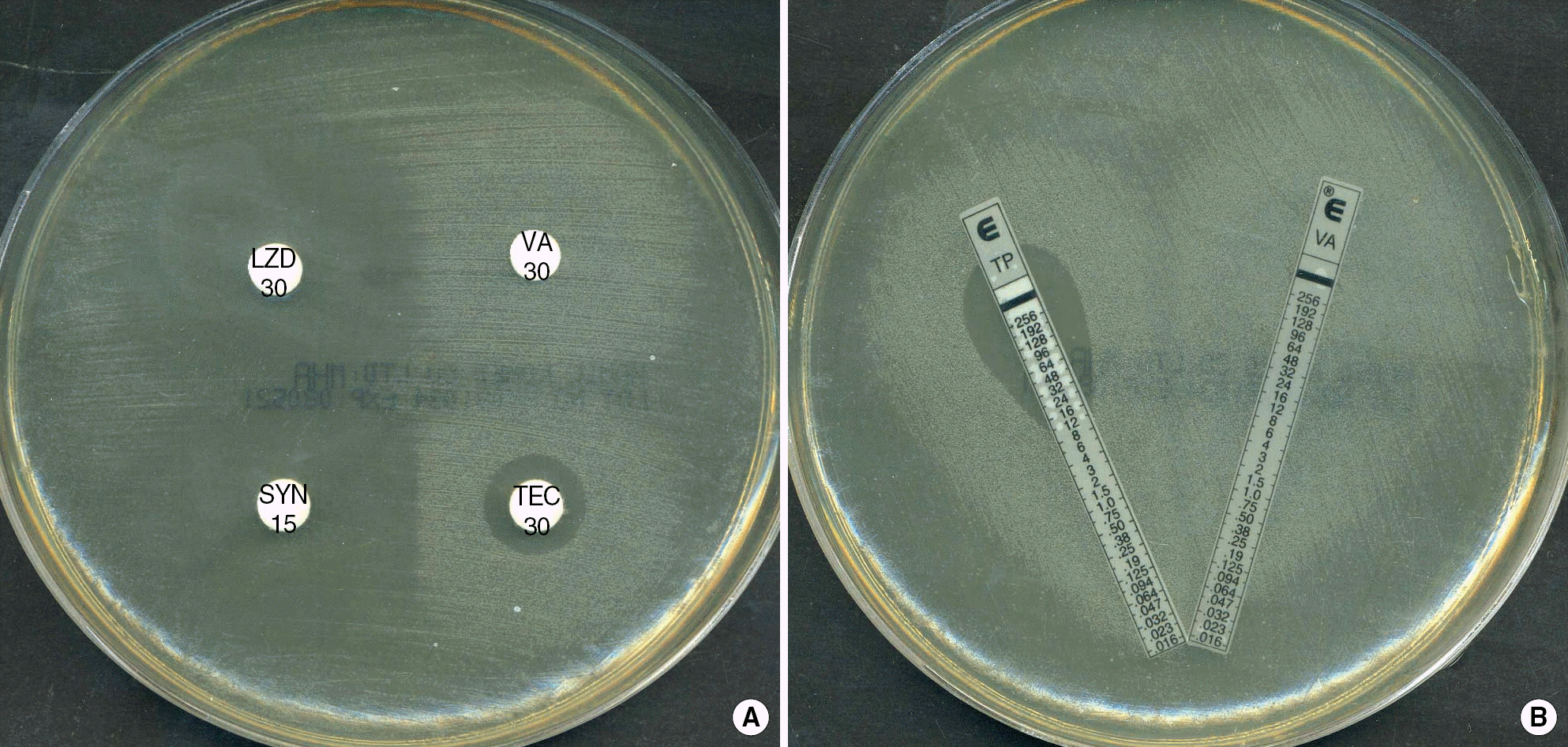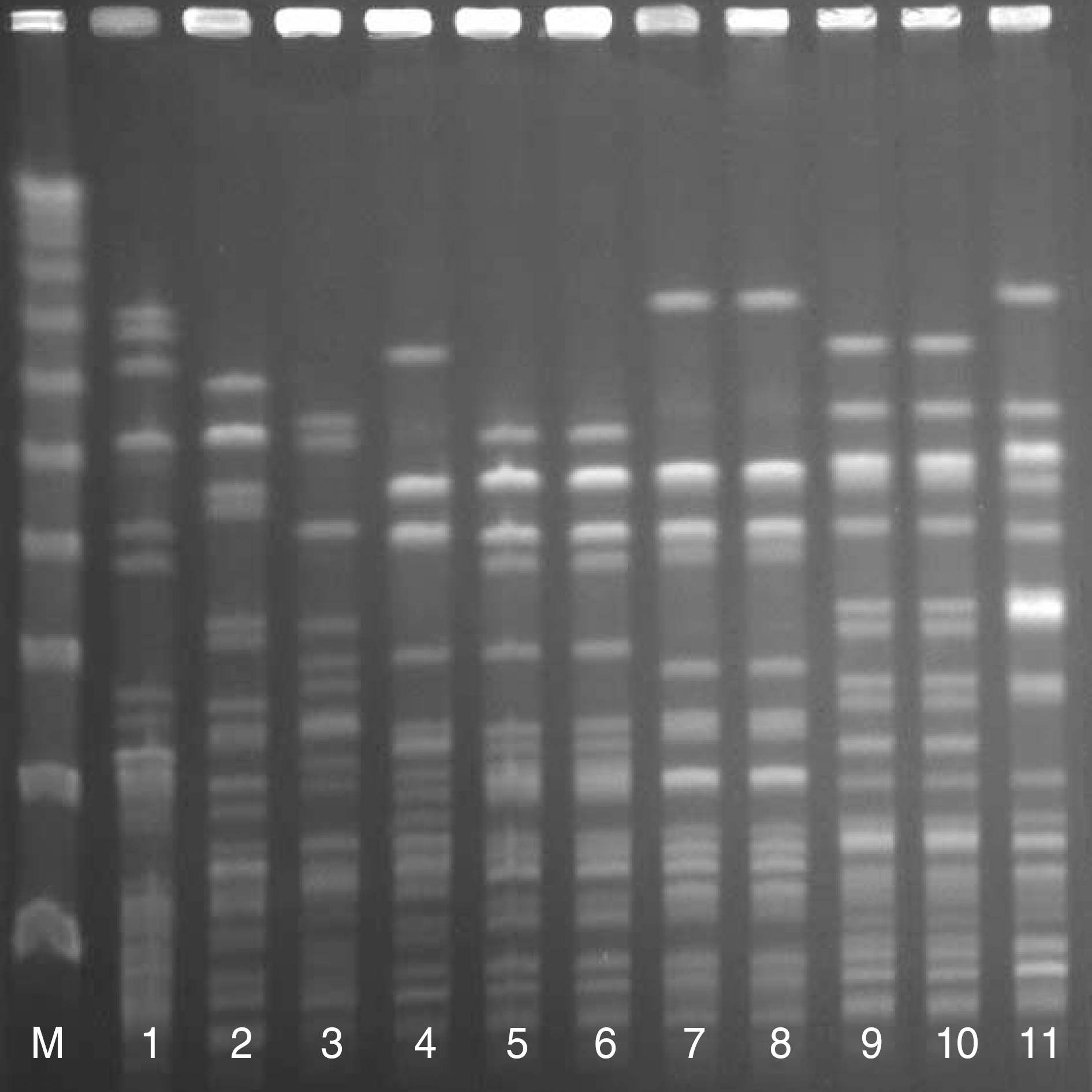Abstract
Background:
Vancomycin-dependent enterococci (VDE) are clinically equivalent to vancomycin-resistant enterococci (VRE), but more difficult to detect. This study was purposed to characterize VDE microbiologically and epidemiologically.
Methods:
The patients from whom VDE were detected from April 2007 to March 2008 were investigated. For available isolates, minimal inhibitory concentrations (MICs) of and the levels of dependence on vancomycin and teicoplanin were measured by E test (AB Biodisk, Sweden), and a test for reversion of VDE to non-dependent VRE (NDVRE) and pulsed field gel electrophoresis (PFGE) were performed. Patients' demographic and clinical findings were reviewed via electronic medical records.
Results:
VDE were recovered from 6 (2.2%) of 272 patients carrying VRE during this study period. All patients were already colonized or infected by VRE and treated with vancomycin for 13 to 107 days. VDE were isolated from pleural fluid (one), urine (four), and stool (one). All isolates carried vanA with vancomycin MICs of >256 μg/mL, but two of them had intermediate susceptibilities to teicoplanin. Because 4 VDE isolates were reverted to NDVRE with single passage, vancomycin dependence was measurable for only two isolates as equal and above 0.064 and 0.5 μg/mL respectively, and was reverted after 5 and 7 passages, respectively. Six VDE isolates showed no related clones in PFGE analysis, and 3 of 4 available pairs of initial VRE isolates and subsequent VDE isolates were identical clones.
REFERENCES
1.Pai CH, Kim MN, editors. Clinical Microbiology for Infection Control. Seoul: Hanmi;2007. p. 96–9. (배직현, 김미나 등 편저. 감염관리를 위한임상미생물학. 서울: 한미의학, 2007:96–9.).
2.Lee WG. Resistance mechanism and epidemiology of vancomycin-resistant enterococci. Korean J Clin Microbiol. 2008. 11:71–7. (이위교 Vancomycin-resistant Enterococci 의내성기전및역학. 대한임상미생물학회지 2008;11:71-7.).

3.Lee WG., Jung MK., Kwak YS. Vancomycin-resistant enterococci: incidence, antimicrobial susceptibility and resistance genotype. Korean J Clin Pathol. 1998. 18:51–6. (이위교, 정민권, 곽연식. Vancomycin 내성 장구균의 분리율, 항균제 감수성 및 내성형에 관한 연구. 대한임상병리학회지 1998;18:51-6.).
4.Fraimow HS., Jungkind DL., Lander DW., Delso DR., Dean JL. Urinary tract infection with Enterococcus faecalis isolate that requires vancomycin for growth. Ann Intern Med. 1994. 121:22–6.
5.Dever LL., Smith SM., Handwerger S., Eng RH. Vancomycin-dependent Enterococcus faecium isolated from stool following oral vancomycin therapy. J Clin Microbiol. 1995. 33:2770–3.
6.Green M., Shlaes JH., Barbadora K., Shlaes DM. Bacteremia due to vancomycin-dependent Enterococcus faecium. Clin Infect Dis. 1995. 20:712–4.
7.Kirkpatrick BD., Harrington SM., Smith D., Marcellus D., Miller C., Dick J, et al. An outbreak of vancomycin-dependent Enterococcus faecium in a bone marrow transplant unit. Clin Infect Dis. 1999. 29:1268–73.
8.Majumdar A., Lipkin GW., Eliott TS., Wheeler DC. Vancomycin-dependent enterococci in a uremic patient with sclerosing peritonitis. Nephrol Dial Transplant. 1999. 14:765–7.
9.Tambyah PA., Marx JA., Maki DG. Nosocomial infection with vancomycin-dependent enterococci. Emerg Infect Dis. 2004. 10:1277–81.
10.Yowler CJ., Blinkhorn RJ., Fratianne RB. Vancomycin-dependent enterococcal strains: case report and review. J Trauma. 2000. 48:783–5.

11.Rosato A., Pierre J., Billot-Klein D., Buu-Hoi A., Gutmann L. Inducible and constitutive expression of resistance to glycopeptides and vancomycin dependence in glycopeptide-resistant Enterococcus avium. Antimicrob Agent Chemother. 1995. 39:830–3.
12.Bert F., Leflon-Guibout V., Grand J., Bourdon N., Nicholas-Chanoine MH. Emergence of vancomycin-dependent enterococci following glycopeptide therapy: case report and review. Pathol Biol. 2009. 57:56–60.
13.Sifaoui F., Gutmann L. Vancomycin dependence in a vanA-producing Enterococcus avium strain with a nonsense mutation in the natural D-ala-D-ala ligase gene. Antimicrob Agents Chemother. 1997. 41:1409.
14.Kim SY., Kang SJ., Lee SO., Lee WG., Park YJ., Kim BK. A case of septicemia by transient glycopeptide-dependent Enterococcus faecium. Korean J Infect Dis. 2002. 34:69–72. (김수영, 강석진, 이승옥, 이위교,박연준, 김병기. 일과성의 glycopeptide 의존성을 보인 Enterococcus faecium 에 의한 패혈증 1예. 감염 2002;34:69-72.).
15.Yoo SJ., Sung H., Cho YU., Kim MN., Pai CH., Kim YS. Role of horizontal transfer of the transposon Tn1546 in the nosocomial spread of vanA vancomycin-resistant enterococci at a tertiary care hospital in Korea. Infect Control Hosp Epidemiol. 2006. 27:1081–7.
16.Lee K., Lim CH., Cho JH., Lee WG., Uh Y., Kim HJ, et al. High prevalence of ceftazidime-resistant Klebsiella pneumoniae and increase of imipenem-resistant Pseudomonas aeruginosa and Acinetobacter spp. in Korea: a KONSAR program in 2004. Yonsei Med J. 2006. 47:634–45.
17.Tanimoto K., Nomura T., Hamatani H., Xiao YH., Ike Y. A vancomycin-dependent VanA-type Enterococcus faecalis strain isolated in Japan from chicken imported from China. Lett Appl Microbiol. 2005. 41:157–62.
18.Lee WG., Huh JY., Cho SR., Lim YA. Reduction in glycopeptide resistance in vancomycin-resistant enterococci as a result of vanA cluster rearrangements. Antimicrob Agents Chemother. 2004. 48:1379–81.
19.Song JH., Ko KS., Suh JY., Oh WS., Kang CI., Chung DR, et al. Clnical implications of vancomycin-resistant Enterococcus faecium (VRE) with VanD phenotype and vanA genotype. J Antimicrob Chemother. 2008. 61:838–44.
20.Van Bambeke F., Chauvel M., Reynolds PE., Fraimow HS., Courvalin P. Vancomycin-dependent Enterococcus faecalis clinical isolates and revertant mutants. Antimicrob Agent Chemother. 1999. 43:41–7.
Fig. 1.
Clinical features of 6 cases growing VDE.
ᅭ periods of hospital stay with numbers denoting hospital days; ⬇, periods of vancomycin therapy; ᐁ, isolation of VRE; ▬, isolation of VDE. ⬩—-⬩, periods of hospital stay of sa- me ward for patient 2 and 3; ⬩…⬩, periods of hospital stay of same ward for patient 4 and 5.
Abbreviations: W, wound; S, stool; U, urine; PF, pleural fluid.

Fig. 2.
Disk diffusion test for vancomycin dependent enterococci isolated from patient 4 showing thick growth only in the area near by vancomycin (VA30) and teicoplanin (TEC30) disks but no growth around linezolid (LZD30) and quinupristin/dalfopristin (SYN15) disks (A). Vancomycin (VA) and teicoplanin (TP) E tests showing dependence on 0.064 μg/mL or more and MIC of 256 μg/mL against vancomycin and dependency of 0.016 μg/mL or more and MIC of 12 μg/mL against teicoplanin (B).

Fig. 3.
Pulsed field gel electrophoretic profiles of SmaI-digested chromosomal DNA of six vancomycin-dependent enterococci and five vancomycin-resistant enterococci. Lane M, Lambda DNA concatomer (New England Biolabs, Beverly, MA, USA); Lane 1, vancomycin-dependent E. avium from patient 1; Lane 2-4, initial vancomycin-resistant E. faecium, subsequent vancomycin-dependent E. faecium and post-VDE vancomycin-resistant E. faecium from patient 2; Lane 5 and 6, initial vancomycin-resistant E. faecium and subsequent vancomycin dependent E. faecium from patient 3; Lane 7 and 8, initial vancomycin-resistant E. faecium and subsequent vancomycin-dependent E. faecium from patient 4; Lane 9 and 10, initial vancomycin-resistant E. faecium and subsequent vancomycin-dependent E. faecium from patient 5; Lane 11, vancomycin-dependent E. faecium from patient 6.

Table 1.
Minimum inhibitory concentration (MIC) of and quantitative dependence on glycopeptides, and the other antimicrobial susceptibility patterns
Abbreviations: VAN, vancomycin; TEC, teicoplanin; PEN, penicillin; AMP, ampicillin; CHL, chloramphenicol; RIF, rifampin; Q-D, quinupristin-dalfopristin; TET, tetracycline; CIP, ciprofloxacin; ERY, erythromycin; GEH, gentamicin high-level resistance; STH, streptomycin high-level resistance; NA, not available; S, susceptible; I, intermediate; R, resistant.




 PDF
PDF ePub
ePub Citation
Citation Print
Print


 XML Download
XML Download